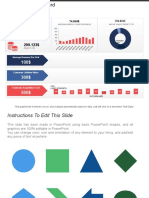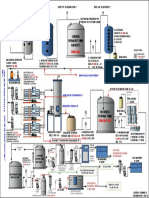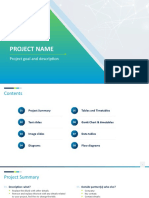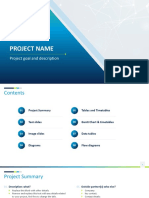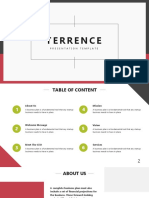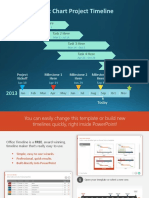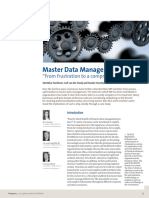Professional Documents
Culture Documents
A Framework For Improving Key Performance Indicators Using Business Intelligence Techniques
Original Title
Copyright
Available Formats
Share this document
Did you find this document useful?
Is this content inappropriate?
Report this DocumentCopyright:
Available Formats
A Framework For Improving Key Performance Indicators Using Business Intelligence Techniques
Copyright:
Available Formats
Volume 6, Issue 10, October – 2021 International Journal of Innovative Science and Research Technology
ISSN No:-2456-2165
A Framework for Improving Key Performance
Indicators using Business Intelligence Techniques
Abdel Nasser H. Zaied Dr. Riham Hagag Assem Khalaf Ahmed
Prof., Professor of Systems Prof., Information systems Business Information Systems
Engineering (Information Systems), Faculty of commerce department
Former Dean, College of Computers Helwan University Faculty of commerce and business
and Informatics, Cairo, Egypt administration
Zagazig University, Egypt. Helwan University Cairo, Egypt
Cairo, Egypt
Abstract:- The study aims to identify the most important II. BUSINESS INTELLIGENCE CONCEPTS
factors affecting the main performance indicators in
business intelligence inside Business Organizations, by A. Definition
classifying them according to the degree of impact on Business intelligence (BI) alludes to the procedural and
them. technical foundation that gathers, stores and analyzes the data
delivered by an organization's activities. Business insight is a
The Data mining methods help to extracts the wide term that incorporates information mining, measure
hidden relation between the data in order to analysis, and examination, execution benchmarking, engaging
then predict information from large databases. One of investigation, etc. Business insight is intended to take in all
the most important tools used in data mining is called the information being created by a business and present
neural networks. It works through learning and simple to process execution measures and patterns that will
prediction. The higher the input values, the greater the illuminate the executive's choice [6].
learning process because it depends on training.
B. Tasks
Keywords:- Business Intelligent, Data Mining, Knowledge The expected advantages We find that all elements and
Discovery, Key Performance Indicators. tools of business intelligence aim to provide and improve
decision-making, simplify and speed up internal processes
I. INTRODUCTION and add an increase operational productivity, driving new
incomes and gaining competitive advantage over business
Dashboards are regularly made out of data display rivals.
technology, including Key Performance Indicators (KPIs)
which assume an essential part in rapidly giving precise data BI frameworks can likewise assist organizations with
by looking at current execution against an objective needed to distinguishing market patterns and spot business issues that
fulfil business targets. In any case, KPIs are not in every case should be tended to [12].
notable and in some cases Hard to find a proper KPIs to
connect with every It aims to work [11]. Business Intelligence frameworks give authentic,
current, and predictive perspectives on business activities,
Business Intelligence frameworks Grants verifiability frequently utilizing information that has been accumulated
and current views of any business activity, we find a lot of into data warehouse or data mart and sometimes working
information used and collected as a whole in the data from operational data [5]. Programming components uphold
warehouse and work intermittently with any information announcing, intuitive "cut up" turn table investigations,
during the operation process. The components of the perception, and factual information mining. Applications
Software elements support the preparation of reports tackle deals, creation, monetary, and numerous different
Interactive pivot table analytics and also mining for wellsprings of business information for purposes that
measurable information [12]. incorporate business execution the executives. Data is
regularly accumulated about different organizations in a
It provides processing applications, whether sales, similar industry which is known as benchmarking [14]. BI
production, finance, and various other sources of business information the stored data warehouse includes historical
data, and its purpose includes business performance information, like the new and modern information that is
management. collected when it is created from the source of the
frameworks, to enable the tools used in Business Intelligence
Data is accumulated regularly about different to provide support for all major, strategic and dynamic
organizations in a similar industry and known as performance processes.
measurement.
IJISRT21OCT210 www.ijisrt.com 295
Volume 6, Issue 10, October – 2021 International Journal of Innovative Science and Research Technology
ISSN No:-2456-2165
III. DATA MINING CONCEPTS is called the information layer, and the last layer is called the
return layer and Between the first and the last layer there is
A. Definition only one layer.
Data mining to enhance decision-making through a
range of computer technologies and applications, this will be Data flows forward relative to the feed forward in one
by applying prediction and description methods to a large direction from the first layer to the last layer. This type of
amount of data to increase decision-making ability, increase network works by what is called a backscattering learning
accuracy, reduce analysis time, reduce poor performance algorithm. MLP are commonly is used configuration request,
indicators used, and increase the decision-making process affirmation, (MLP) can tackle issues which cannot be
through it because it is extracted from Through cached data distinguished directly [28].
neural networks that provide business intelligence assistance
in organizations [7]. 2) Neural Network (Probabilistic):
Class problems Here we can use (PNN). If an entry is
B. Tasks submitted, the distances in the initial layer are calculated
A large number of tasks suitable for the use of records starting from the input vector and ending with the training
in general will be collecting, evaluating, forecasting, vectors and producing a direction indicating the direction
estimating, and clustering, with outlining. An assortment of from the training input to the center [29].
them will in general be best drawn nearer in the top-down
design just although, in general, an incremental In the second layer, the contributions of each class of
approximation is preferred, called discovery, which often inputs are combined so that its net output is directed to the
leads to cancellation of regression [10]. possibilities. And then on most of those possibilities, the
feature of switching outputs appears. You have a choice of
With respect to Classification, is the highest well- the second layer options that produce either one for a specific
known information mining undertaking and it comprises of category or zero for any other category.
analyzing the highlights of a recently introduced object to
appoint for a pre-selected group of categories [18]. Probabilistic Neural Network It is an architecture of
neural networks that is useful and has a well-defined basis
However order manages Partial results, with results of with little backpropagation, but it feeds the structure forward
continuing value, appreciation is treated. In fact, evaluation is to be similar to the posterior diffusion. PNN is supervised
used regularly to perform a classification task [24]. learning set of rules but consists of and in the hidden layer,
there are no weights [30].
Expectation manages the grouping of records as
indicated by some anticipated future conduct or assessed 3) Neural Network (Linear):
future worth. Both are close gathering and mart crate (LN) provides a benchmark by which we can examine
examination with as a target to decide Things that can be put the overall performance of a neural network. In other cases, a
together. Grouping targets sectioning a heterogeneous complex problem can be solved by means of a linear network,
populace into various many homogeneous groups and as happens in neural networks. It is used in the case of a small
subgroups are also not previously identified. number of training cases, and here you do not need a model
that is more complex.
The goal is to present data well, so the complex
operations that take place in databases are described and In the case of a specific input with vectors, the result is
explained [25]. an output directed to the target it corresponds to. Each vector
has an input, and we hope for the time from calculating an
C. Data Mining (Classification Techniques) output vector to the network. Each of them differs in error in
Here we find, a set of records in databases is assigned relation to the output vector and the input vector. In the event
to a sample class or tag for classification from a large set of that you want to find a value for each weight in the network
predefined class labels. For example, the organization will be to reduce all the error boxes to a minimum and to the lowest
eager to classifying each of them. All the options, as well as value. The problem is that linear networks have simple errors.
the yes or no option, belong to classification problems. The For most cases, we can compute a linear network
rating has at least more than one level, for example, "high," immediately, with the error being the lowest of the input
"medium," and "low." The central matter the number of vectors [30].
classes is limited. It is noted who can be there a verifiable
request we find the relationship inside the definition of each 4) Neural Network (Radial Basis Function):
layer, for example, "high," "medium," and "low." [27]. Neural Network (Radial Basis Function) it is based on
a supervised learning algorithm which is pre-fed. Usually it
Neural Network Proposed Techniques: consists through one hidden layer of a group of tools to
choose to activate its own function through some of the
1) Multilayer Perceptrons Neural Network features referred to called base features.
Multi-Layer perceptron (MLP) is a stock forward neural
A network consists of at least one layer of the input layer as
well as the output layer, The first layer is the main layer and
IJISRT21OCT210 www.ijisrt.com 296
Volume 6, Issue 10, October – 2021 International Journal of Innovative Science and Research Technology
ISSN No:-2456-2165
This network has many advantages, it works in a faster IV. PROPOSED SOLUTION
way and is less prone to input problems and the reason is the
radiation behavior of each hidden unit. A. A Framework of improving key performance indicators
using Business Intelligence Techniques
The design of that network consists of three layers, but The first figure shows the real A Framework for
each part is separate from the other, which is a group of nodes improving key performance indicators in the research paper.
in the case of input and in the case of output, so the reaction That the mining Techniques implemented the improving key
of the network to each type of input layers or the second layer performance indicators through the use of neural networks
is hidden and its dimensions are redundant. and Comparison the Classification results of Neural
Networks, the Radial basis Function, Multi-Layer Perceptron,
It constitutes a class of different artificial neural Linear and Probabilistic Neural Network to choosing the best
networks, and its advantages over other different networks result of neural network in data classification, for Application
appear in terms of simple form and study in a faster manner. of best Key performance indicators (KPIs) by using Business
These types of networks depend heavily on an estimate of intelligence Techniques to enhances to effectiveness to
many of the parameters: weights, centers, and widths that link support and decision making.
through the neural network [7].
Fig. 1. A Framework for improving key performance indicators using Business Intelligence Techniques
B. A Framework stages: That way is followed to take neutral and clear and
1)Data Sources" Collecting ": influential data in the process of measuring performance
Structured interview with expert (IT Department). indicators to solve problems in the data warehouse.
The data acquisition documents using paper and flash
memories. 3) The Transformation Process
Note taking. Real data It includes all the data collected from the
conducted Interviews in person or over the telephone sector used for the measurement process of performance
Interviews done formally (structured) or semi-structured indicators, it is usually inconsistent, in addition to sometimes
there is a lot of missing and unclear data, so an integration
2) The Data Extraction process is carried out for the data and the missing data is
Through the research paper, the data used in measuring completed and the inconsistent data is excluded, and the
performance indicators were collected within one sectors, and process of changing those data will start to work ERP
the presence of duplicate data will lead to mistakes and low Schema.
performance in the Neural Networks.
IJISRT21OCT210 www.ijisrt.com 297
Volume 6, Issue 10, October – 2021 International Journal of Innovative Science and Research Technology
ISSN No:-2456-2165
i. The Missing value: V. TARGET DATA SET
The missing data is deleted or replaced, and in the case
of the replacement process, by setting a numerical rate based The research paper applied 65% of records purposed for
on the existing data, in a mean substitution, the average value coaching the neural network and 35% will maybe be
of a variable is used in place of the missing data value for that implemented as a completely impartial test on the network.
same variable.
Also, that is because of the fact, if the neural network
ii. The Noisy data : has been Implementation for a passing extravagant pair of
The noisy data are data with a large amount of information which were helpful for the training, it will not be
additional meaningless information in it called noise. It also particular it found to "prediction" or to "saving" pattern.
includes any data that a user system cannot understand and
interpret correctly, the error can be in the calculated values, The neural network needs to increase the training
and there are many methods that handle the wrong data such process. Whenever new inputs are introduced into the neural
as clustering, it is able to handle the errors inside the data that network, it trains on it and learns through it. Therefore, it was
resulted from different operations. necessary to perform two operations: the first process, which
is the input process, and the next process is the training
iii. The Inconsistent data: process for the network.
The Inconsistent data is generally exacerbated by data
redundancy. However, it differs from data redundancy in that VI. CONCLUSIONS
it usually points to problems with the content of the database
rather than its design and structure. The aim of the research paper is to present A New
Framework for improving key performance indicators using
There are data inconsistencies in many transactions that Business Intelligence Technics As data mining, which greatly
need to be resolved, There is a lot of existing data that has helps in extracting hidden relationships between data , and
been repaired and modified and prevent the presence of such improving the new key performance indicators that will be
contradictory data within the data warehouse. followed by the institution and try to choose the best indicator
among a group of indicators, and Ensuring successful access
iv. Data Integration: to institutions for their goals (improvement - correct
Data collecting from many sources. Data integration deviations - making decisions) and measuring the success
helps to avoid inconsistencies and improve mining speed and rates of the institution, and Identify the most important
quality. factors affecting decision-making by classifying them by
degree of impact.
This is done by saving all the data in the data warehouse
and using more than one method to access that data in one REFERENCES
place and a several database, Careful integration of data from
multiple resources helps reduce and prevent redundancy and [1]. Abd El-Aziz Ahmed, Hesham A. Hefny, Mohammed
disparity in the data set that they cause. This can help boost Badawy (2018). Exploring and Measuring the Key
accuracy, reliability, and rate from your next mining process. Performance Indicators in Higher Education
Institutions, International Journal of Intelligent
v. Data Selection: Computing & Information Science, Volume18.
Selecting relations of data of given fascination for the [2]. Ahmed Mohamed Abd El-Mongy, Alaa el-Deen
research is the simplest manner to collect very last outcomes Hamouda, Nihal Nounou, Abdel-Moneim A. Wahdan
distinctly applicable to the lookup requirements. (2013), Design of Prediction System for Key
Performance Indicators in Balanced Scorecard.
This paper choose the right variables effect acquisition International Journal of Computer Applications ,
the best KPIs instances as suggestions for improvement, [3]. Alaskar T. and Poulis E. (2015). Business Intelligence
including deferent number of data transactions, Internal Data Capabilities and Implementation Strategies.
Sources and External Data Sources, choosing the factors that International Journal of Global Business 8(1), .
are supported as a result, This selection will improving key [4]. Albert P.C. Chan, Ada P.L. Chan, (2004) "Key
performance indicators. performance indicators for measuring construction
success", Benchmarking: An International Journal, Vol.
vi.Data Transformation: 11.
We find that the data transformed during the [5]. Fink L., Yogev N. and Even A. (2017).Enhancing the
normalization method is very useful for classification Business Value of Business Intelligence: The Role of
algorithms as well as for neural networks. Shared Knowledge and Assimilation. Journal of
Information Systems.
Normalization greatly helps each computed property to [6]. Gonzales, R., Wareham, J., Serida, J. (2015). :
develop the learning process, this method of normalization Measuring the Impact of Data Warehouse and Business
processes all data in appropriate forms to perform data Intelligence on Enterprise Performance in Peru: A
mining. Developing Country. Journal of Global Information
Technology Management. 18 .
IJISRT21OCT210 www.ijisrt.com 298
Volume 6, Issue 10, October – 2021 International Journal of Innovative Science and Research Technology
ISSN No:-2456-2165
[7]. Gordon S. Linoff, Michael J. Berry(2011): Data Mining [22]. Višnja Istrat, Sanja Stanisavljev, Branko
Techniques: For Marketing, Sales, and Customer Markoski(2015), the role of business intelligence in
Relationship Management. Wiley Computer Publishing; decision process modelin,the European journal of
3rd Ed. applied economics .
[8]. Hanelt, A., B. Hildebrandt and J. Polier (2015). [23]. Vo, Quoc Duy et al (2017). "Next Generation Business
“Uncovering the role of is in business model innovation Intelligence and Analytics." IEEE Communication
– a taxonomy-driven aproach to structure the field.” In: Surveys & Tutorial.
Twenty-Third European Conference on Information [24]. whitepaper(2017),Key Performance Indicators, Six
Systems (ECIS). Münster, Germany. Hartmann. Sigma, and Data Mining, Data Driven Decision Making
[9]. Jesús Peral⁎, Alejandro Maté, Manuel for Financial Institutions, Information Technology
Marco(2017),Application of Data Mining techniques to [25]. Jiawei Han, Micheline Kamber, and Jian Pei: Data
identify relevant Key Performance Indicators. Journal Mining: Concepts and Techniques, 3rd Ed., Morgan
Computers & Industrial Engineering. Kaufmann Publishers, Mar. 2011
[10]. Jiawei Han, Micheline Kamber, and Jian Pei(2011): [26]. Ying Huang, Bing Quan Huang, M. Tahar Kechadi: A
Data Mining: Concepts and Techniques, 3rd Ed., Rule-Based Method for Customer Churn Prediction in
Morgan Kaufmann Publishers. Telecommunication Services. PAKDD 2011: 411-422
[11]. Julia furmankiewicz, Małgorzata furmankiewicz, piotr [27]. Nhien-An Le-Khac, Martin Bue, Michael Whelan, M.
ziuziański(2015),implementation of business Tahar Kechadi: A Clustering-Based Data Reduction for
intelligence performance dashboard for the knowledge Very Large Spatio-Temporal Datasets. ADMA 2010:
management in organization, Computer Publishing. 43-54
[12]. Mari Abe, Jun-Jang Jeng, Yinggang Li (2007), A Tool [28]. S.Xu, M.Zhang, “Data mining - an adaptive neural
Framework for KPI Application Development. IEEE network model for financial analysis” Information
International Conference on e-Business Engineering. Technology and Applications, IEEE, ICITA, pp.336-
[13]. Navin K. Deva, Ravi Shankarb, Rachita Guptac, Jingxin 340, 2005.
Dongd(2017),Multi-criteria evaluation of real-time key [29]. J.Rabunal, J.Dorado, “Artificial neural networks in
performance indicators of supply chain with real-life applications”, pp.297-303, 2006.
consideration of big data architecture, Journal [30]. X.Ni, “Research of Data Mining Based on Neural
Computers & Industrial Engineering. Networks”, World Academy of Science, Engineering
[14]. OlszakC.M.(2016).Toward Better Understanding and and Technology 39, 2008.
Use of Business Intelligence in Organizations. [31]. Y.Singh, A.Singh chauhan, “NEURAL NETWORKS
Information Systems Management . IN DATA MINING”, Journal of Theoretical and
[15]. Popovicˇ A. and Yeoh W. (2016).Approach to Building Applied Information Technology, 2009.
and Implementing Business Intelligence Systems.
Interdisciplinary Journal of Information, Knowledge,
and Management.
[16]. Richards G, Yeoh W, Chong AY-L, et al. (2014) An
empirical study of business intelligence impact on
corporate performance management. PACIS 2014:
Proceedings of the Pacific Asia Conference on
Information Systems 2014. AIS eLiberary.
[17]. Ruhollah Tavallaei, Sajad Shokohyar , Seyedeh Mehrsa
Moosavi , Zahra Sarfi (2015)Assessing the Evaluation
Models of Business Intelligence Maturity and
Presenting an Optimized Model , International Journal
of Management, Accounting and Economics.
[18]. Salmasi, M. K., Talebpour, A., & Homayounvala, E.
(2016). Identification and classification of
organizational level competencies for BI success.
Journal of Intelligence Studies in Business.
[19]. Sangar, A. B., Hesar, Z. E., Asl, M. S. and Tahmores,
K. (2015). Research article proposing IS success models
for measuring business intelligence system (BIS)
success and analytical literature review on BIS
measurement. ANARE Res.
[20]. Stodder, David (2017). Using Design Thinking to
Unleash Creativity in BI and Analytics Development.
Renton, WA: tdwi.
[21]. Stodder, David (2017). Accelerating the Path to Value
with Business Intelligence and Analatics. TDWI.
IJISRT21OCT210 www.ijisrt.com 299
You might also like
- Team Kaizen - Workshop Team Session 3Document49 pagesTeam Kaizen - Workshop Team Session 3Festina LovaNo ratings yet
- Dashboard Free PowerPoint TemplateDocument6 pagesDashboard Free PowerPoint TemplateAnca IonelaNo ratings yet
- Jessica SlidesCarnivalDocument39 pagesJessica SlidesCarnivalBianca AdelinaNo ratings yet
- Edi Process FlowDocument1 pageEdi Process FlowEnggel BernabeNo ratings yet
- Business KPI Dashboard Showing Average Revenue and CLVDocument6 pagesBusiness KPI Dashboard Showing Average Revenue and CLVHimanshu ChavanNo ratings yet
- Check List: Your Title Text HereDocument2 pagesCheck List: Your Title Text HereFatima GorineNo ratings yet
- Root Cause Analysis: Christine Lyman, Sr. Manager Jan 2015Document9 pagesRoot Cause Analysis: Christine Lyman, Sr. Manager Jan 2015Šyed FarîsNo ratings yet
- Power Bi: Business Intelligent ToolDocument11 pagesPower Bi: Business Intelligent ToolSahanabalikai XworkzNo ratings yet
- EDI PresentationDocument15 pagesEDI Presentationshafiqk84100% (1)
- Business Data Analytics Students-1-2 PDFDocument30 pagesBusiness Data Analytics Students-1-2 PDFSiddharth KumarNo ratings yet
- Date Warehouse: How Could We Implement DWH in BedefDocument33 pagesDate Warehouse: How Could We Implement DWH in BedefbeirensgNo ratings yet
- Power Bi Intro 2Document4 pagesPower Bi Intro 2yasNo ratings yet
- Cultural Diversity Brown VariantDocument51 pagesCultural Diversity Brown VariantNelly RNo ratings yet
- Total Cost of Ownership For Business Intelligence PDFDocument10 pagesTotal Cost of Ownership For Business Intelligence PDFolivia cortezNo ratings yet
- 03 Power BI Governance - SureshChanges AutosavedDocument22 pages03 Power BI Governance - SureshChanges AutosavedBruno MartinsNo ratings yet
- Exercise Solutions: For TDWI Data ModelingDocument8 pagesExercise Solutions: For TDWI Data ModelingsuNo ratings yet
- Infographic: The Modernization of The Data WarehouseDocument1 pageInfographic: The Modernization of The Data WarehouseInam Ullah BukhariNo ratings yet
- Build Interactive Excel DashboardsDocument22 pagesBuild Interactive Excel DashboardsBrian DsouzaNo ratings yet
- 04 - Modern Data Lake Powered by Data Virtualization & AI - Le Bui HungDocument19 pages04 - Modern Data Lake Powered by Data Virtualization & AI - Le Bui HungDinh ThongNo ratings yet
- Kaseya Product Presentation Final v2.0Document24 pagesKaseya Product Presentation Final v2.0Kunal PradhanNo ratings yet
- Power BI Information PackDocument4 pagesPower BI Information PackPeddy NesaNo ratings yet
- Learning in Digital TransformationDocument10 pagesLearning in Digital TransformationSandèép YadavNo ratings yet
- Brochure-UpGrad & IIIT-B Data Analytics Program PDFDocument9 pagesBrochure-UpGrad & IIIT-B Data Analytics Program PDFArpit LambaNo ratings yet
- 3-3-6 Plan Quality and IVV PlanDocument5 pages3-3-6 Plan Quality and IVV PlangridechNo ratings yet
- Power Bi Report: Design FactorsDocument15 pagesPower Bi Report: Design Factorsezequiel diaz montillaNo ratings yet
- Cbme Chap 9 FinallllDocument28 pagesCbme Chap 9 FinallllKirk Rumar ClavelNo ratings yet
- Vector Icon Pack: Specially Crafted by - TAQI'UDDIN HAMZAHDocument49 pagesVector Icon Pack: Specially Crafted by - TAQI'UDDIN HAMZAHMuhammad Fitri Abd LatipNo ratings yet
- 1b-032.13 Whitepaper New Vi Agile Bi 17th Oct13 Final Web Secured 1Document20 pages1b-032.13 Whitepaper New Vi Agile Bi 17th Oct13 Final Web Secured 1Jancy LonyNo ratings yet
- Technology Infographics by SlidesgoDocument29 pagesTechnology Infographics by SlidesgoTrân HứaNo ratings yet
- (v1.0.3) PowerBI Interactive TutorialDocument27 pages(v1.0.3) PowerBI Interactive TutorialRamesh KomarapuriNo ratings yet
- How To Choose The Right Data VisualizationDocument18 pagesHow To Choose The Right Data VisualizationMandar GadkariNo ratings yet
- PO Implementation: Conception DocumentDocument47 pagesPO Implementation: Conception DocumentMihai FildanNo ratings yet
- Business RoadmapDocument14 pagesBusiness RoadmapttirvNo ratings yet
- StorSimple New Business Models Sellers PartnersDocument16 pagesStorSimple New Business Models Sellers PartnersGustavo MartínezNo ratings yet
- Project Name: Project Goal and DescriptionDocument39 pagesProject Name: Project Goal and DescriptionMaheen MehmoodNo ratings yet
- Balanced ScorecardDocument14 pagesBalanced ScorecardriaNo ratings yet
- BusinessDocument50 pagesBusinessTuongVNguyenNo ratings yet
- Banking Performance Management: Rajesh Shewani Presales Leader, BA Software IBM India/SADocument20 pagesBanking Performance Management: Rajesh Shewani Presales Leader, BA Software IBM India/SARajesh Kumar100% (1)
- Integrating Sap Business Objects Xcelsius and Web Intelligence Reporting With Sap Netweaver BW and Sap Netweaver PortalDocument45 pagesIntegrating Sap Business Objects Xcelsius and Web Intelligence Reporting With Sap Netweaver BW and Sap Netweaver Portalsaprsa1No ratings yet
- Blue Light (Autosaved)Document46 pagesBlue Light (Autosaved)sonkarmanishNo ratings yet
- Program Kerja Bagian Keuangan 2020Document59 pagesProgram Kerja Bagian Keuangan 2020RSIANo ratings yet
- Pivot Data Design-Jennifer NultyDocument11 pagesPivot Data Design-Jennifer Nultyapi-314439984No ratings yet
- Slidesmash Powerpoint Light SlidesDocument44 pagesSlidesmash Powerpoint Light Slidestania__starNo ratings yet
- Project OverviewDocument39 pagesProject OverviewAmit SheoranNo ratings yet
- Recruitment TipsDocument7 pagesRecruitment TipsDeepa NairNo ratings yet
- Terrence Powerpoint TemplateDocument51 pagesTerrence Powerpoint TemplateJose Luis Barrientos AguirreNo ratings yet
- Flat Design LettersDocument30 pagesFlat Design LettersSyamsul HidayatNo ratings yet
- Annual Report Powerpoint TemplateDocument40 pagesAnnual Report Powerpoint TemplateTeam Advertising HARDIANNo ratings yet
- Customer Journey Map Template: Eiusmod Tempor Incididunt Ut LaboreDocument14 pagesCustomer Journey Map Template: Eiusmod Tempor Incididunt Ut LaboreAlbertoNo ratings yet
- Business Case Ppt-CorporateDocument24 pagesBusiness Case Ppt-CorporateTripti SagarNo ratings yet
- Free Gantt Chart Template GuideDocument9 pagesFree Gantt Chart Template Guidemahrad100% (1)
- Gantt Chart Project Timeline: Task 1 HereDocument4 pagesGantt Chart Project Timeline: Task 1 HereJuan CarlosNo ratings yet
- PPT Process Flow TemplateDocument14 pagesPPT Process Flow TemplateAshique Iqbal AbeerNo ratings yet
- It Supportnow Supportnow Phone Numbers: It Support Quick Reference GuideDocument2 pagesIt Supportnow Supportnow Phone Numbers: It Support Quick Reference GuideAnonymous u8bpZ58No ratings yet
- Steelwedge Rapid Implementation MethodologyDocument13 pagesSteelwedge Rapid Implementation MethodologyNarayan SubramanianNo ratings yet
- Procurement Processes and Master DataDocument60 pagesProcurement Processes and Master Datalaurablue96No ratings yet
- Master Data Management Business CaseDocument6 pagesMaster Data Management Business CaseRavi RNo ratings yet
- Director Business Intelligence Analytics in Phoenix AZ Resume Tracy PowersDocument2 pagesDirector Business Intelligence Analytics in Phoenix AZ Resume Tracy PowersTracyPowersNo ratings yet
- Indrasol's PeopleSoft Support ServicesDocument10 pagesIndrasol's PeopleSoft Support ServicesSudheer NagireddyNo ratings yet
- Automatic Power Factor ControllerDocument4 pagesAutomatic Power Factor ControllerInternational Journal of Innovative Science and Research TechnologyNo ratings yet
- Intelligent Engines: Revolutionizing Manufacturing and Supply Chains with AIDocument14 pagesIntelligent Engines: Revolutionizing Manufacturing and Supply Chains with AIInternational Journal of Innovative Science and Research TechnologyNo ratings yet
- Navigating Digitalization: AHP Insights for SMEs' Strategic TransformationDocument11 pagesNavigating Digitalization: AHP Insights for SMEs' Strategic TransformationInternational Journal of Innovative Science and Research TechnologyNo ratings yet
- A Review: Pink Eye Outbreak in IndiaDocument3 pagesA Review: Pink Eye Outbreak in IndiaInternational Journal of Innovative Science and Research TechnologyNo ratings yet
- Teachers' Perceptions about Distributed Leadership Practices in South Asia: A Case Study on Academic Activities in Government Colleges of BangladeshDocument7 pagesTeachers' Perceptions about Distributed Leadership Practices in South Asia: A Case Study on Academic Activities in Government Colleges of BangladeshInternational Journal of Innovative Science and Research TechnologyNo ratings yet
- Securing Document Exchange with Blockchain Technology: A New Paradigm for Information SharingDocument4 pagesSecuring Document Exchange with Blockchain Technology: A New Paradigm for Information SharingInternational Journal of Innovative Science and Research TechnologyNo ratings yet
- Mobile Distractions among Adolescents: Impact on Learning in the Aftermath of COVID-19 in IndiaDocument2 pagesMobile Distractions among Adolescents: Impact on Learning in the Aftermath of COVID-19 in IndiaInternational Journal of Innovative Science and Research TechnologyNo ratings yet
- Studying the Situation and Proposing Some Basic Solutions to Improve Psychological Harmony Between Managerial Staff and Students of Medical Universities in Hanoi AreaDocument5 pagesStudying the Situation and Proposing Some Basic Solutions to Improve Psychological Harmony Between Managerial Staff and Students of Medical Universities in Hanoi AreaInternational Journal of Innovative Science and Research TechnologyNo ratings yet
- Review of Biomechanics in Footwear Design and Development: An Exploration of Key Concepts and InnovationsDocument5 pagesReview of Biomechanics in Footwear Design and Development: An Exploration of Key Concepts and InnovationsInternational Journal of Innovative Science and Research TechnologyNo ratings yet
- Perceived Impact of Active Pedagogy in Medical Students' Learning at the Faculty of Medicine and Pharmacy of CasablancaDocument5 pagesPerceived Impact of Active Pedagogy in Medical Students' Learning at the Faculty of Medicine and Pharmacy of CasablancaInternational Journal of Innovative Science and Research TechnologyNo ratings yet
- Formation of New Technology in Automated Highway System in Peripheral HighwayDocument6 pagesFormation of New Technology in Automated Highway System in Peripheral HighwayInternational Journal of Innovative Science and Research TechnologyNo ratings yet
- Natural Peel-Off Mask Formulation and EvaluationDocument6 pagesNatural Peel-Off Mask Formulation and EvaluationInternational Journal of Innovative Science and Research TechnologyNo ratings yet
- Drug Dosage Control System Using Reinforcement LearningDocument8 pagesDrug Dosage Control System Using Reinforcement LearningInternational Journal of Innovative Science and Research TechnologyNo ratings yet
- The Effect of Time Variables as Predictors of Senior Secondary School Students' Mathematical Performance Department of Mathematics Education Freetown PolytechnicDocument7 pagesThe Effect of Time Variables as Predictors of Senior Secondary School Students' Mathematical Performance Department of Mathematics Education Freetown PolytechnicInternational Journal of Innovative Science and Research TechnologyNo ratings yet
- Enhancing the Strength of Concrete by Using Human Hairs as a FiberDocument3 pagesEnhancing the Strength of Concrete by Using Human Hairs as a FiberInternational Journal of Innovative Science and Research TechnologyNo ratings yet
- Supply Chain 5.0: A Comprehensive Literature Review on Implications, Applications and ChallengesDocument11 pagesSupply Chain 5.0: A Comprehensive Literature Review on Implications, Applications and ChallengesInternational Journal of Innovative Science and Research TechnologyNo ratings yet
- Advancing Opthalmic Diagnostics: U-Net for Retinal Blood Vessel SegmentationDocument8 pagesAdvancing Opthalmic Diagnostics: U-Net for Retinal Blood Vessel SegmentationInternational Journal of Innovative Science and Research TechnologyNo ratings yet
- The Making of Self-Disposing Contactless Motion-Activated Trash Bin Using Ultrasonic SensorsDocument7 pagesThe Making of Self-Disposing Contactless Motion-Activated Trash Bin Using Ultrasonic SensorsInternational Journal of Innovative Science and Research TechnologyNo ratings yet
- Placement Application for Department of Commerce with Computer Applications (Navigator)Document7 pagesPlacement Application for Department of Commerce with Computer Applications (Navigator)International Journal of Innovative Science and Research TechnologyNo ratings yet
- REDLINE– An Application on Blood ManagementDocument5 pagesREDLINE– An Application on Blood ManagementInternational Journal of Innovative Science and Research TechnologyNo ratings yet
- Beyond Shelters: A Gendered Approach to Disaster Preparedness and Resilience in Urban CentersDocument6 pagesBeyond Shelters: A Gendered Approach to Disaster Preparedness and Resilience in Urban CentersInternational Journal of Innovative Science and Research TechnologyNo ratings yet
- Exploring the Clinical Characteristics, Chromosomal Analysis, and Emotional and Social Considerations in Parents of Children with Down SyndromeDocument8 pagesExploring the Clinical Characteristics, Chromosomal Analysis, and Emotional and Social Considerations in Parents of Children with Down SyndromeInternational Journal of Innovative Science and Research TechnologyNo ratings yet
- Handling Disruptive Behaviors of Students in San Jose National High SchoolDocument5 pagesHandling Disruptive Behaviors of Students in San Jose National High SchoolInternational Journal of Innovative Science and Research TechnologyNo ratings yet
- Safety, Analgesic, and Anti-Inflammatory Effects of Aqueous and Methanolic Leaf Extracts of Hypericum revolutum subsp. kenienseDocument11 pagesSafety, Analgesic, and Anti-Inflammatory Effects of Aqueous and Methanolic Leaf Extracts of Hypericum revolutum subsp. kenienseInternational Journal of Innovative Science and Research TechnologyNo ratings yet
- A Curious Case of QuadriplegiaDocument4 pagesA Curious Case of QuadriplegiaInternational Journal of Innovative Science and Research TechnologyNo ratings yet
- A Knowledg Graph Model for e-GovernmentDocument5 pagesA Knowledg Graph Model for e-GovernmentInternational Journal of Innovative Science and Research TechnologyNo ratings yet
- Analysis of Financial Ratios that Relate to Market Value of Listed Companies that have Announced the Results of their Sustainable Stock Assessment, SET ESG Ratings 2023Document10 pagesAnalysis of Financial Ratios that Relate to Market Value of Listed Companies that have Announced the Results of their Sustainable Stock Assessment, SET ESG Ratings 2023International Journal of Innovative Science and Research TechnologyNo ratings yet
- Pdf to Voice by Using Deep LearningDocument5 pagesPdf to Voice by Using Deep LearningInternational Journal of Innovative Science and Research TechnologyNo ratings yet
- Adoption of International Public Sector Accounting Standards and Quality of Financial Reporting in National Government Agricultural Sector Entities, KenyaDocument12 pagesAdoption of International Public Sector Accounting Standards and Quality of Financial Reporting in National Government Agricultural Sector Entities, KenyaInternational Journal of Innovative Science and Research TechnologyNo ratings yet
- Fruit of the Pomegranate (Punica granatum) Plant: Nutrients, Phytochemical Composition and Antioxidant Activity of Fresh and Dried FruitsDocument6 pagesFruit of the Pomegranate (Punica granatum) Plant: Nutrients, Phytochemical Composition and Antioxidant Activity of Fresh and Dried FruitsInternational Journal of Innovative Science and Research TechnologyNo ratings yet
- The Production and Interpretation of Ritual Transformation Experience: A Study on the Method of Physical Actions of the Baishatun Mazu PilgrimageDocument36 pagesThe Production and Interpretation of Ritual Transformation Experience: A Study on the Method of Physical Actions of the Baishatun Mazu PilgrimageMinmin HsuNo ratings yet
- The UFO Book Encyclopedia of The Extraterrestrial (PDFDrive)Document756 pagesThe UFO Book Encyclopedia of The Extraterrestrial (PDFDrive)James Lee Fallin100% (2)
- ADII11 Metode Deteksi OutlierDocument50 pagesADII11 Metode Deteksi Outlier21-A-2-19 Nazli Amaliya RamadhaniNo ratings yet
- Mayan Calendar End Date Sparks Doomsday SpeculationDocument16 pagesMayan Calendar End Date Sparks Doomsday SpeculationElfen RoxanneNo ratings yet
- Advanced Scan I21no2Document29 pagesAdvanced Scan I21no2Jaiber SosaNo ratings yet
- Lec08 (Topic 4 Define Classes)Document33 pagesLec08 (Topic 4 Define Classes)huaiencheengNo ratings yet
- Subject and Content NotesDocument52 pagesSubject and Content NotesJoe Carl CastilloNo ratings yet
- Popular Mechanics 2010-06Document171 pagesPopular Mechanics 2010-06BookshebooksNo ratings yet
- 4.3 Structural Analysis 4.3.1 ModellingDocument8 pages4.3 Structural Analysis 4.3.1 Modellingdavid ROBALINONo ratings yet
- Maths Note P1 and P3Document188 pagesMaths Note P1 and P3Afeefa SaadatNo ratings yet
- Stylistic and DiscourseDocument4 pagesStylistic and Discourseeunhye carisNo ratings yet
- Alside Brochure - Zen Windows The TriangleDocument13 pagesAlside Brochure - Zen Windows The TriangleZenWindowsTheTriangleNo ratings yet
- ERC12864-12 DemoCode 4wire SPI 2Document18 pagesERC12864-12 DemoCode 4wire SPI 2DVTNo ratings yet
- 21 Great Answers To: Order ID: 0028913Document13 pages21 Great Answers To: Order ID: 0028913Yvette HOUNGUE100% (1)
- Chemistry 101 - The Complete Notes - Joliet Junior College (PDFDrive)Document226 pagesChemistry 101 - The Complete Notes - Joliet Junior College (PDFDrive)Kabwela MwapeNo ratings yet
- CommunicationDocument5 pagesCommunicationRyan TomeldenNo ratings yet
- Siart, Et. Al (2018) Digital GeoarchaeologyDocument272 pagesSiart, Et. Al (2018) Digital GeoarchaeologyPepe100% (2)
- UN Habitat UPCL Myanmar TranslationDocument254 pagesUN Habitat UPCL Myanmar TranslationzayyarNo ratings yet
- Sewer CadDocument10 pagesSewer CadAlvaro Jesus Añazco YllpaNo ratings yet
- Studying Supply and Demand of Software Maintenance and Evolution ServicesDocument6 pagesStudying Supply and Demand of Software Maintenance and Evolution ServicesJorge Arturo Moreno VeasNo ratings yet
- E 74 - 06 - For Force Measuring InstrumentsDocument12 pagesE 74 - 06 - For Force Measuring InstrumentsSarvesh MishraNo ratings yet
- VLSI Physical Design: From Graph Partitioning To Timing ClosureDocument30 pagesVLSI Physical Design: From Graph Partitioning To Timing Closurenagabhairu anushaNo ratings yet
- ADL MATRIX STRATEGY FOR BPCL'S GROWTHDocument17 pagesADL MATRIX STRATEGY FOR BPCL'S GROWTHSachin Nagar100% (1)
- Exhaust Brake PDFDocument2 pagesExhaust Brake PDFFeliciaNo ratings yet
- Empowerment Technology - Week 2Document3 pagesEmpowerment Technology - Week 2yahgieNo ratings yet
- Electromagnetic Braking SystemDocument14 pagesElectromagnetic Braking SystemTanvi50% (2)
- CEILING BOARDING GUIDEDocument5 pagesCEILING BOARDING GUIDEahahNo ratings yet
- TCBE - Conversation Skills TemplateDocument10 pagesTCBE - Conversation Skills TemplateAryoma GoswamiNo ratings yet
- Limits, Fits and Tolerances: Prof. S. S. PandeDocument31 pagesLimits, Fits and Tolerances: Prof. S. S. PandeM PankajNo ratings yet


